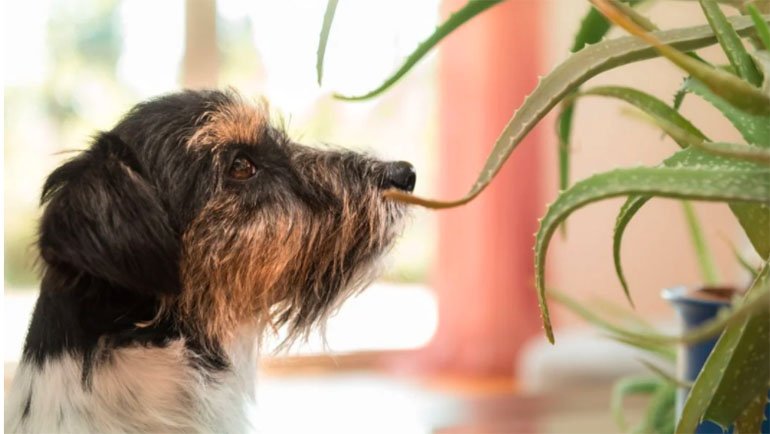For those who don’t know, Aloe vera is a succulent, evergreen, perennial plant of the genus Aloe.
In spite of its cactus-like appearance, Aloe vera belongs to the Lilly family and originally grows in tropical and semitropical regions of the world.
Nowadays, Aloe vera is a popular plant due to its incredible versatility in use and high content of vitamins.
Its antibacterial, antiviral, antifungal and anti-inflammatory properties contribute to Aloe vera’s popularity and make it a powerful addition to any first-aid kit.
The great thing is that applies not only to you but for your furry pouch too. Yes, if properly and topically used, Aloe vera is a canine-friendly plant.
However, as always, if you do decide on using products based on Aloe vera make sure they are labeled as pet-friendly before using them on your dog.
How to safely use Aloe vera
The Aloe vera is a hardy plant, capable of living under any conditions.
Therefore, raw Aloe vera is easy to use. All you need to do is go to your nearest supermarket, buy an aloe plant, place it in the kitchen and snap off a leaf whenever needed.
When cutting or snapping leaves, it is important to start with the ones on the bottom. The next step is squeezing out the juice, this is the most critical part because the inside of the Aloe vera plant contains two layers.
The center, which is green and aqueous is safe, while the outer layer contains a white sap, known as latex. The latex is toxic for all animals.
Take caution not to contaminate the juice or gel with the latex and always avoid applying Aloe vera to areas of your dog they can reach easily and lick. If you’re still worried about latex commitation then many commercial Aloe vera already have latex removed but always do your research on a product by product basis.
Aloe vera and skin benefits
Historically speaking, Aloe vera has been used for healing wounds, burns, dry and cracked skin, as well as different forms of dermatitis for several centuries.
However, it was not until recently that scientist extracted a novel protein from the Aloe vera that acts as a powerful antifungal agent.
The protein, named 14kDa, is particularly potent against species of the Candida family (C. albicans, C. krusei, C. paraprilosis).
Considering the fact that in most cases of chronically itchy skin conditions in dogs, the underlying cause is an internal Candida overgrowth, it can be derived that using Aloe vera is beneficial for their skin.
Common skin conditions in dogs with underlying fungal basis include:
- Sore, yeasty ears
- Dandruff
- Dry and cracked noses and paws
- Ringworm
- Hot spots
- Yeast infections in skin folds
- Interdigital cysts
Here is a more indepth breadown of some of the key issues listed above and how Aloe vera can be used to ease your dog’s ailment.
Dandruff
Dandruff is often caused by little fungi that live in the skin’s pores.
Aloe vera soothes the irritated pores and moisturizes and nourishes the dry skin around the pores. Additionally, Aloe vera kills the fungi that caused the problem. To achieve best results, bath your dog in Aloe vera, let the liquid soak in for 30 minutes and then rinse out.
Ringworm
Ringworm or Microsporidia is a type of fungus that hates Aloe vera.
The best way of treating ringworm in dogs is by rubbing raw Aloe vera, Aloe vera juice or Aloe vera gel on the affected areas of the skin.
For easier applying you can use a cotton pad to dap the Aloe vera directly. The rubbing can be performed at least two to three times per day.
The benefits of the Aloe vera for the dog’s skin go far beyond its antifungal powers.
The Aloe vera has the power to penetrate the skin more effectively than any other skin product.
Therefore Aloe vera can be used for soothing irritated itchy changes on your dog’s skin. The Aloe vera not only soothes the skin but also reduces the inflammation.
Before applying the Aloe vera on the skin it is advised to wash the affected area with lukewarm water.
If put on new, open wounds the Aloe vera forms a biofilm that protects the wound from getting infected.
Warning It should be noted that after the initial Aloe vera use, the treated wound or skin irritation may appear worse.
Do not be alarmed, because that is a normal effect.
In fact, Aloe vera is capable of inducing a so-called ‘’healing crisis’’.
The Aloe vera increases the skin’s healing rate and reduces the healing time by initiating extra profusion to the tissue. This phase can last for several days. After that, you will be able to see an improvement. If not sure, you can always use Aloe vera on one area and compare the treated area with the untreated area.
Aloe vera poisoning in dogs
Unfortunately, if not properly used, Aloe vera can be toxic for dogs.
There are 2 types of Aloe vera poisoning in dogs:
Acute – occurs if the dog consumes large quantities
Chronic – occurs if the dog is exposed to smaller quantities of Aloe vera plants or products but over a longer period of time.
Symptoms to be wary of
Common symptoms of Aloe vera poisoning in dogs include:
- Abdominal pain
- Bloating
- Anorexia
- Vomiting
- Weight loss
- Diarrhea
- Drooling
- Impaired breathing
- Changed heart rate
- Dark urine
- Fever
- Dilated pupils
- Head shaking
- Incoordination
- Nausea
- Lethargy
- Depression
- Muscle twitches and seizures
- Coma
If you’re concerned abot any of the above symptoms always consult your vetirnanain as soon as possible.
Why a propoer diagnosis is needed and how it will be conducted
The diagnosis will be based on either the history of exposure retrieved by talking with the owner (if they actually saw the dog eating Aloe vera or if they treated the dog with Aloe vera themselves) and presenting clinical signs. If the owner is not aware of what happened than the diagnosis should be based on the results retrieved by examining the dog, as well as the presenting clinical signs.
To rule out signs of potential organ failures, the vet will perform a blood analysis (including a full blood cell count and blood biochemistry profile), a urinalysis and an ultrasound of the abdomen. To detect heart abnormalities and arrhythmias he is likely to perform an EKG.
Treatment
Treating Aloe vera poisoning in dogs includes:
Decontamination (by inducing vomiting and giving active charcoal or performing gastric lavage)
Symptomatic therapy (depends on the clinical manifestation)
Supportive therapy (IV fluids and oxygen for keeping the patient stable and hydrated).
Prognosis
The prognosis depends on the severity of the case – how much the dog swallowed and how fast it received proper treatment.
Wrapping Up
Taking everything into consideration it can be concluded that Aloe vera is safe for dogs as long as it is used properly.
When putting the accent on the term properly, it must be noted that Aloe vera is intended only for topical treatment in dogs. Aloe vera should never be given orally. This means that you should also only apply Aloe very to parts of your dogs body that they can’t lick.
Responsible dog owners should educate themselves and practice caution when using products that contain Aloe vera. The best way to eliminate the risk of accidents is by putting an Elizabethan collar on your dog when treating it with Aloe vera products.


1 comment